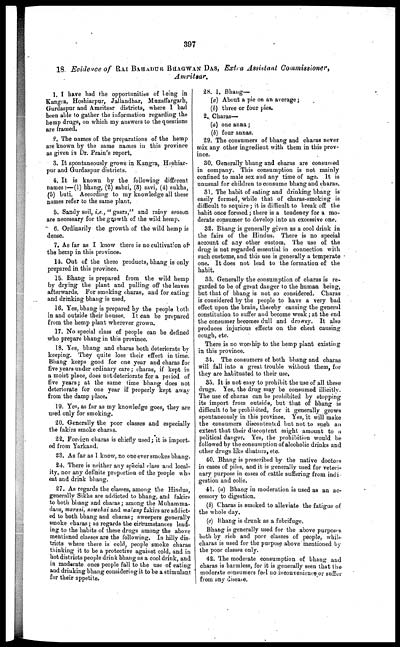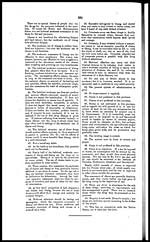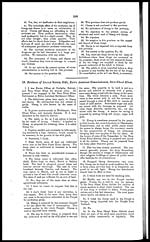Medicine - Drugs > Report of the Indian Hemp Drugs Commission, 1894-1895 > Volume V
(417) Page 397
Download files
Individual page:
Thumbnail gallery: Grid view | List view

397
18.Evidence of RAI BAHADUR BHAGWAN DAS, Extra Assistant Commissioner,
Amritsar.
1.I have had the opportunities of being in
Kangra, Hoshiarpur, Jallandbar, Muzaffargarh,
Gurdaspur and Amritsar districts, where I had
been able to gather the information regarding the
hemp drugs, on which my answers to the questions
are framed.
9.The names of the preparations of the hemp
are known by the same names in this province
as given in Dr. Prain's report.
3.It spontaneously grows in Kangra, Hoshiar-
pur and Gurdaspur districts.
4.It is known by the following different
names:—(1) bhang, (2) sabzi, (8) savi, (4) sukha,
(5) buti. According to my knowledge all these
names refer to the same plant.
5.Sandy soil, i.e., "gasra," and rainy season
are necessary for the growth of the wild hemp.
6.Ordinarily the growth of the wild hemp is
dense.
7.As far as I know there is no cultivation of
the hemp in this province.
14.Out of the three products, bhang is only
prepared in this province.
15.Bhang is prepared from the wild hemp
by drying the plant and pulling off the leaves
afterwards. For smoking charas, and for eating
and drinking bhang is used.
16.Yes, bhang is prepared by the people both
in and outside their houses. It can be prepared
from the hemp plant wherever grown.
17.No special class of people can be defined
who prepare bhang in this province.
18.Yes, bhang and charas both deteriorate by
keeping. They quite lose their effect in time.
Bhang keeps good for one year and charas for
five years under ordinary care; charas, if kept in
a moist place, does not deteriorate for a period of
five years; at the same lime bhang does not
deteriorate for one year if properly kept away
from the damp place.
19.Yes, as far as my knowledge goes, they are
used only for smoking.
20.Generally the poor classes and especially
the fakirs smoke charas.
22.Foreign charas is chiefly used; it is import-
ed from Yarkand.
23.As far as 1 know, no one ever smokes bhang.
24.There is wither any special class and local-
ity, nor any definite proportion of the people who
eat and drink bhang.
27.As regards the classes, among the Hindus,
generally Sikhs are addicted to bhang, and fakirs
to both bhang and charas; among the Muhamma-
dans, marasi, nowshai and malang fakirs are addict-
ed to both bhang and charas; sweepers generally
smoke charas; as regards the circumstances lead-
ing to the habits of these drugs among the above
mentioned classes are the following. In hilly dis-
tricts where there is cold, people smoke charas
thinking it to be a protective against cold, and in
hot districts people drink bhang as a cool drink, and
in moderate ones people fall to the use of eating
and drinking bhang considering it to be a stimulant
for their appetite.
28.1. Bhang-
(a) About a pie on an average;
(b) three or four pies.
2.Charas—
(a)one anna;
(b)four annas.
29.The consumers of bhang and charas never
mix any other ingredient with them in this prov-
ince.
30.Generally bhang and charas are consumed
in company. This consumption is not mainly
confined to male sex and any time of age. It is
unusual for children to consume bhang and charas.
31.The habit of eating and drinking bhang is
easily formed, while that of charas-smoking is
difficult to acquire; it is difficult to break off the
habit once formed; there is a tendency for a mo-
derate consumer to develop into an excessive one.
32.Bhang is generally given as a cool drink in
the fairs of the Hindus. There is no special
account of any other custom. The use of the
drug is not regarded essential in connection with
such customs, and this use is generally a temperate
one. It does not lead to the formation of the
habit.
33.Generally the consumption of charas is re-
garded to be of great danger to the human being,
but that of bhang is not so considered. Charas
is considered by the people to have a very bad
effect upon the brain, thereby causing the general
constitution to suffer and become weak; at the end
the consumer becomes dull and drowsy. It also
produces injurious effects on the chest causing
cough, etc.
There is no worship to the hemp plant existing
in this province.
34.The consumers of both bhang and charas
will fall into a great trouble without them, for
they are habituated to their use.
35.It is not easy to prohibit the use of all these
drugs. Yes, the drug may be consumed illicitly.
The use of charas can be prohibited by stopping
its import from outside, but that of bhang is
difficult to be prohibited, for it generally grows
spontaneously in this province. Yes, it will make
the consumers discontented but not to such an
extent that their discontent might amount to a
political danger. Yes, the prohibition would be
followed by the consumption of alcoholic drinks and
other drugs like dhatura, etc.
40.Bhang is prescribed by the native doctors
in cases of piles, and it is grenerally used for veteri-
nary purpose in cases of cattle suffering from indi
gestion and colic.
41.(a) Bhang in moderation is used as an ac-
cessory to digestion.
(b)Charas is smoked to alleviate the fatigue of
the whole day.
(c)Bhang is drunk as a febrifuge.
Bhang is generally used for the above purposes
both by rich and poor classes of people, while
charas is used for the purpose above mentioned by
the poor classes only.
42.The moderate consumption of bhang and
charas is harmless, for it is generally seen that the
moderate consumers feel no inconvenience or suffer
from any disease.
Set display mode to: Large image | Zoom image | Transcription
Images and transcriptions on this page, including medium image downloads, may be used under the Creative Commons Attribution 4.0 International Licence unless otherwise stated. ![]()
| India Papers > Medicine - Drugs > Report of the Indian Hemp Drugs Commission, 1894-1895 > Volume V > (417) Page 397 |
|---|
| Permanent URL | https://digital.nls.uk/75122082 |
|---|
| Description | Volume 5: Evidence of witnesses from North-Western Provinces and Oudh and Punjab. Answers from witnesses in North-Western Provinces, Oudh and Punjab about cultivation and growth of hemp, preparation or manufacture, trade, consumption or use, effects, administration - taxation and control. |
|---|---|
| Attribution and copyright: |
|




